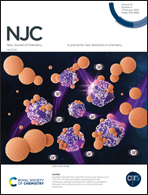Theoretical investigations on reactivity influencing factors of ˙Mn(CO)5 catalyzed alkyne hydrosilylation and hydrogermylation†
Abstract
The transition metal-catalyzed alkyne functionalization reaction can produce useful organic reagents and is the most atom-economical, green and sustainable process for combining triple bonds in functional molecules. In this work, the mechanism of the alkyne hydrogermylation reaction catalyzed by ˙Mn(CO)5 and factors influencing reactivity have been investigated based on DFT calculations. The calculated results show that the whole reaction involves three processes: the first hydrogen atom transfer (HAT) process, the radical transformation process, and the second HAT process. The radical transformation process is the rate-determining step. The title reactions have good selectivities and the Z-Pro are the main products. The mechanisms of hydrosilylation and hydrogermylation of alkynes are similar, except that the energy barrier of hydrogermylation is lower than that of hydrosilylation. The period of E (E = C, Si, Ge and Sn) atoms in HEPhMe2, the substituents on alkynes and HEPhMe2, and the nature of solvents are related to the reactivity of the title reaction. The greater positive charge on the E atom and more aromatic substituents on alkynes lead to greater reactivity. The more negative Vs,min of the solvent leads to the lower yield of the reaction. Our results provide a detailed explanation of the experimental results and shed light on the further development of the alkyne-functionalization reaction.



 Please wait while we load your content...
Please wait while we load your content...